Evaluating Strategic Leadership: Influence, Power, and Business Edge
VerifiedAdded on 2023/06/08
|8
|2395
|263
Essay
AI Summary
This essay provides an analysis of strategic leadership, focusing on the roles of leaders in directing, influencing, and motivating teams to achieve organizational goals. It assesses the leadership qualities of Steve Jobs at Apple Inc., exploring how leaders use influence and power, including legitimate, referent, expert, reward, coercive, and informational power, to drive performance. The essay also identifies key features and needs for leadership development to gain a competitive edge, emphasizing the importance of trust, communication, innovation, and adaptability. Furthermore, it discusses criteria for evaluating a business's strategic effectiveness from a leadership perspective, highlighting the leader's role in guiding, directing, and motivating team members while managing business values. The conclusion emphasizes that effective leadership requires a range of skills and features that benefit both the organization and its members, positioning leaders as motivators, coaches, and influencers.
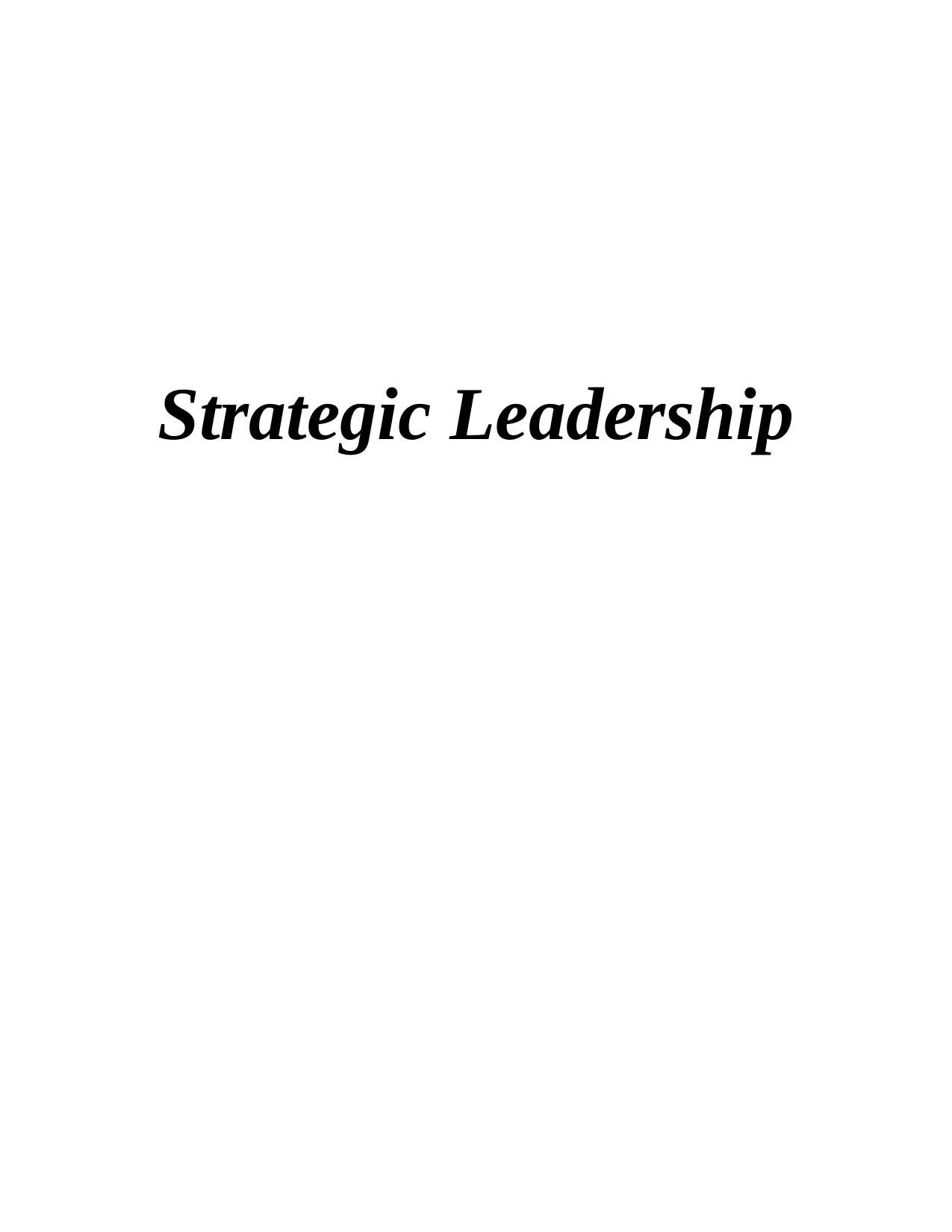
Strategic Leadership
Paraphrase This Document
Need a fresh take? Get an instant paraphrase of this document with our AI Paraphraser
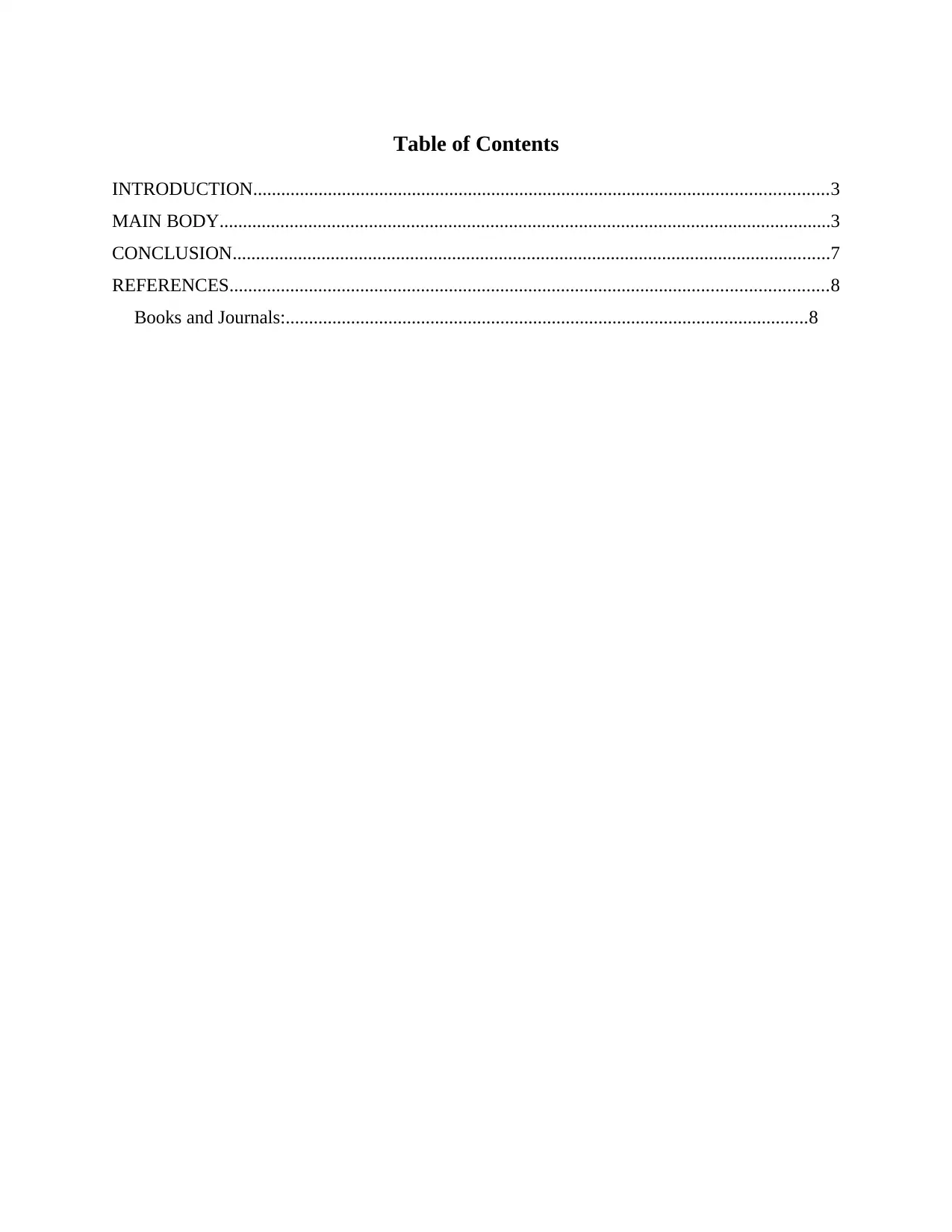
Table of Contents
INTRODUCTION...........................................................................................................................3
MAIN BODY...................................................................................................................................3
CONCLUSION................................................................................................................................7
REFERENCES................................................................................................................................8
Books and Journals:................................................................................................................8
INTRODUCTION...........................................................................................................................3
MAIN BODY...................................................................................................................................3
CONCLUSION................................................................................................................................7
REFERENCES................................................................................................................................8
Books and Journals:................................................................................................................8
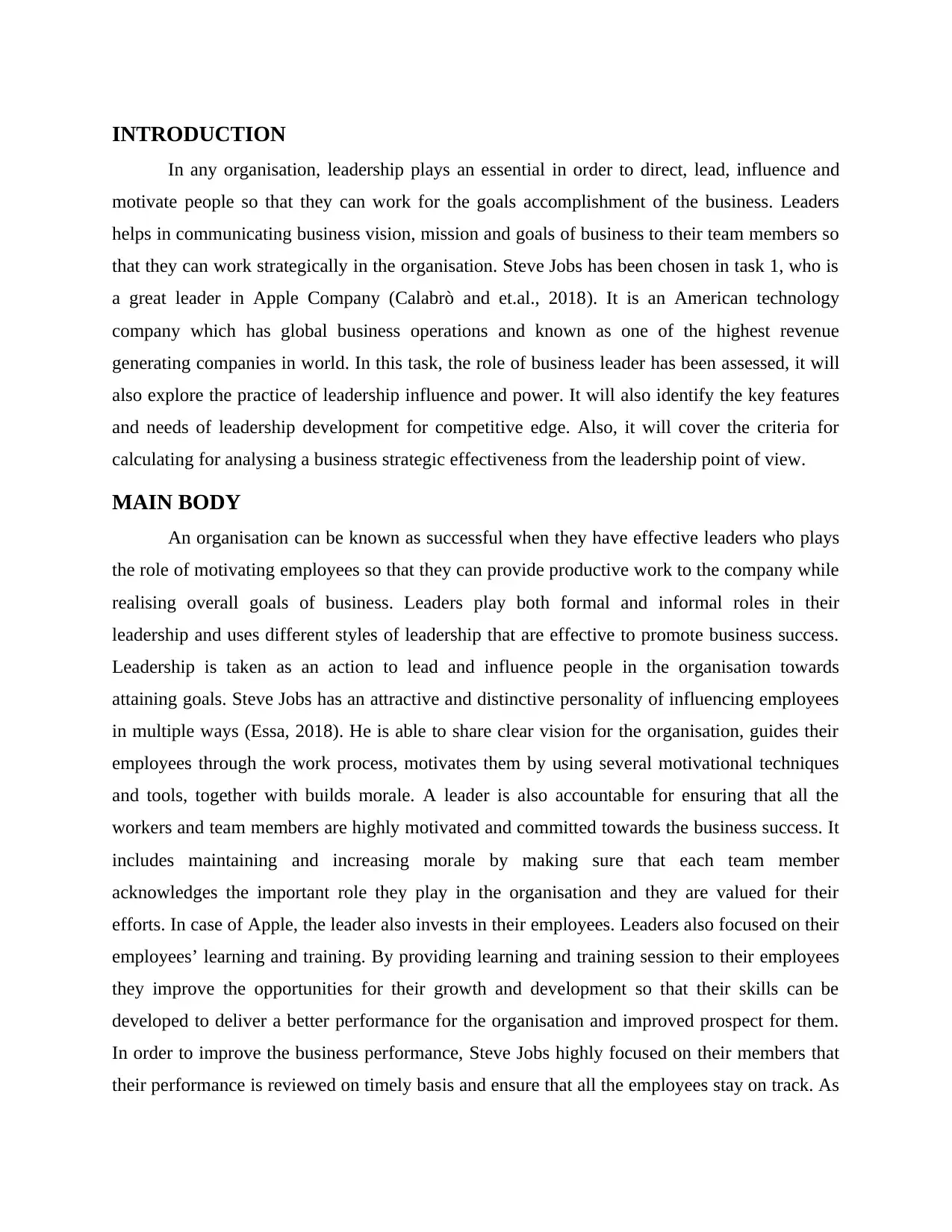
INTRODUCTION
In any organisation, leadership plays an essential in order to direct, lead, influence and
motivate people so that they can work for the goals accomplishment of the business. Leaders
helps in communicating business vision, mission and goals of business to their team members so
that they can work strategically in the organisation. Steve Jobs has been chosen in task 1, who is
a great leader in Apple Company (Calabrò and et.al., 2018). It is an American technology
company which has global business operations and known as one of the highest revenue
generating companies in world. In this task, the role of business leader has been assessed, it will
also explore the practice of leadership influence and power. It will also identify the key features
and needs of leadership development for competitive edge. Also, it will cover the criteria for
calculating for analysing a business strategic effectiveness from the leadership point of view.
MAIN BODY
An organisation can be known as successful when they have effective leaders who plays
the role of motivating employees so that they can provide productive work to the company while
realising overall goals of business. Leaders play both formal and informal roles in their
leadership and uses different styles of leadership that are effective to promote business success.
Leadership is taken as an action to lead and influence people in the organisation towards
attaining goals. Steve Jobs has an attractive and distinctive personality of influencing employees
in multiple ways (Essa, 2018). He is able to share clear vision for the organisation, guides their
employees through the work process, motivates them by using several motivational techniques
and tools, together with builds morale. A leader is also accountable for ensuring that all the
workers and team members are highly motivated and committed towards the business success. It
includes maintaining and increasing morale by making sure that each team member
acknowledges the important role they play in the organisation and they are valued for their
efforts. In case of Apple, the leader also invests in their employees. Leaders also focused on their
employees’ learning and training. By providing learning and training session to their employees
they improve the opportunities for their growth and development so that their skills can be
developed to deliver a better performance for the organisation and improved prospect for them.
In order to improve the business performance, Steve Jobs highly focused on their members that
their performance is reviewed on timely basis and ensure that all the employees stay on track. As
In any organisation, leadership plays an essential in order to direct, lead, influence and
motivate people so that they can work for the goals accomplishment of the business. Leaders
helps in communicating business vision, mission and goals of business to their team members so
that they can work strategically in the organisation. Steve Jobs has been chosen in task 1, who is
a great leader in Apple Company (Calabrò and et.al., 2018). It is an American technology
company which has global business operations and known as one of the highest revenue
generating companies in world. In this task, the role of business leader has been assessed, it will
also explore the practice of leadership influence and power. It will also identify the key features
and needs of leadership development for competitive edge. Also, it will cover the criteria for
calculating for analysing a business strategic effectiveness from the leadership point of view.
MAIN BODY
An organisation can be known as successful when they have effective leaders who plays
the role of motivating employees so that they can provide productive work to the company while
realising overall goals of business. Leaders play both formal and informal roles in their
leadership and uses different styles of leadership that are effective to promote business success.
Leadership is taken as an action to lead and influence people in the organisation towards
attaining goals. Steve Jobs has an attractive and distinctive personality of influencing employees
in multiple ways (Essa, 2018). He is able to share clear vision for the organisation, guides their
employees through the work process, motivates them by using several motivational techniques
and tools, together with builds morale. A leader is also accountable for ensuring that all the
workers and team members are highly motivated and committed towards the business success. It
includes maintaining and increasing morale by making sure that each team member
acknowledges the important role they play in the organisation and they are valued for their
efforts. In case of Apple, the leader also invests in their employees. Leaders also focused on their
employees’ learning and training. By providing learning and training session to their employees
they improve the opportunities for their growth and development so that their skills can be
developed to deliver a better performance for the organisation and improved prospect for them.
In order to improve the business performance, Steve Jobs highly focused on their members that
their performance is reviewed on timely basis and ensure that all the employees stay on track. As
⊘ This is a preview!⊘
Do you want full access?
Subscribe today to unlock all pages.

Trusted by 1+ million students worldwide
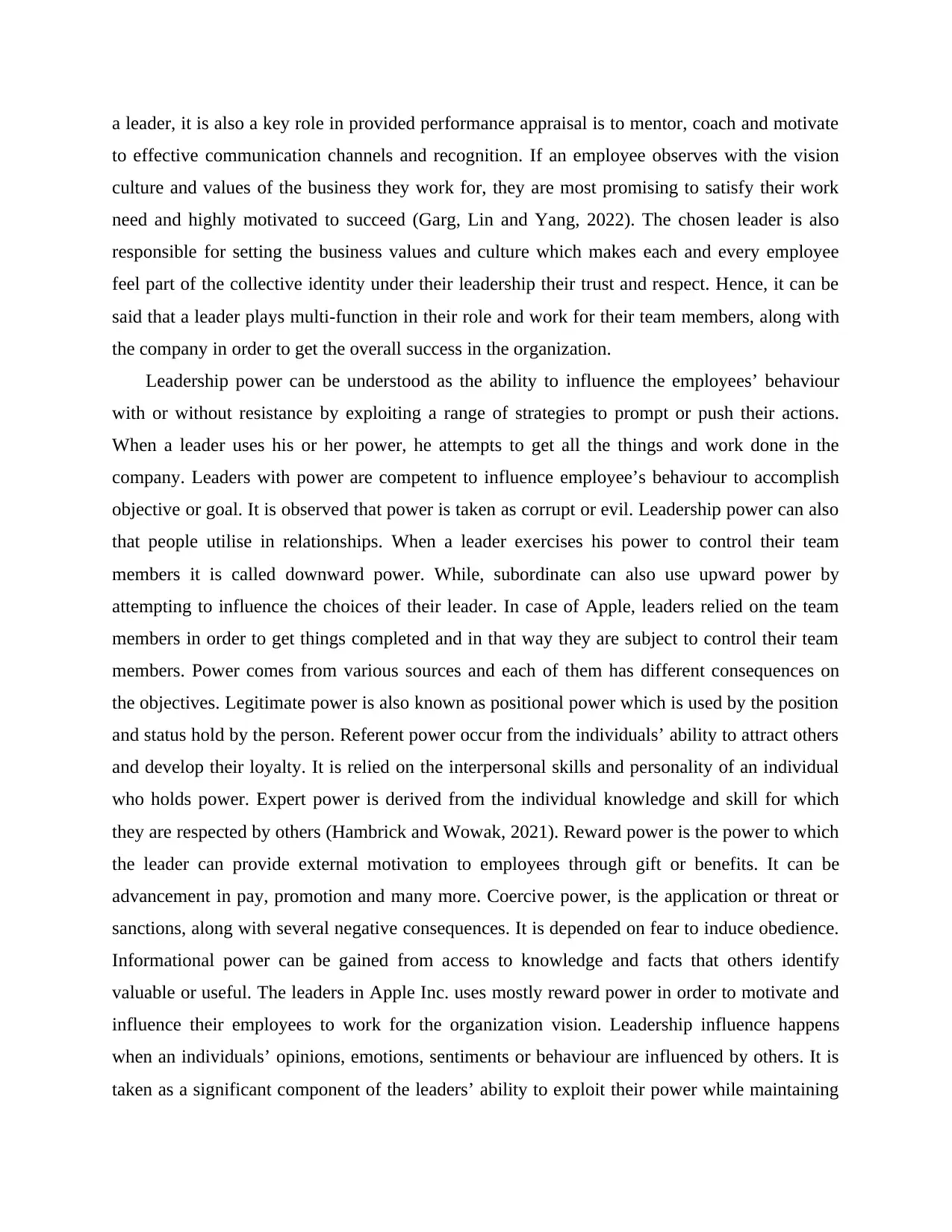
a leader, it is also a key role in provided performance appraisal is to mentor, coach and motivate
to effective communication channels and recognition. If an employee observes with the vision
culture and values of the business they work for, they are most promising to satisfy their work
need and highly motivated to succeed (Garg, Lin and Yang, 2022). The chosen leader is also
responsible for setting the business values and culture which makes each and every employee
feel part of the collective identity under their leadership their trust and respect. Hence, it can be
said that a leader plays multi-function in their role and work for their team members, along with
the company in order to get the overall success in the organization.
Leadership power can be understood as the ability to influence the employees’ behaviour
with or without resistance by exploiting a range of strategies to prompt or push their actions.
When a leader uses his or her power, he attempts to get all the things and work done in the
company. Leaders with power are competent to influence employee’s behaviour to accomplish
objective or goal. It is observed that power is taken as corrupt or evil. Leadership power can also
that people utilise in relationships. When a leader exercises his power to control their team
members it is called downward power. While, subordinate can also use upward power by
attempting to influence the choices of their leader. In case of Apple, leaders relied on the team
members in order to get things completed and in that way they are subject to control their team
members. Power comes from various sources and each of them has different consequences on
the objectives. Legitimate power is also known as positional power which is used by the position
and status hold by the person. Referent power occur from the individuals’ ability to attract others
and develop their loyalty. It is relied on the interpersonal skills and personality of an individual
who holds power. Expert power is derived from the individual knowledge and skill for which
they are respected by others (Hambrick and Wowak, 2021). Reward power is the power to which
the leader can provide external motivation to employees through gift or benefits. It can be
advancement in pay, promotion and many more. Coercive power, is the application or threat or
sanctions, along with several negative consequences. It is depended on fear to induce obedience.
Informational power can be gained from access to knowledge and facts that others identify
valuable or useful. The leaders in Apple Inc. uses mostly reward power in order to motivate and
influence their employees to work for the organization vision. Leadership influence happens
when an individuals’ opinions, emotions, sentiments or behaviour are influenced by others. It is
taken as a significant component of the leaders’ ability to exploit their power while maintaining
to effective communication channels and recognition. If an employee observes with the vision
culture and values of the business they work for, they are most promising to satisfy their work
need and highly motivated to succeed (Garg, Lin and Yang, 2022). The chosen leader is also
responsible for setting the business values and culture which makes each and every employee
feel part of the collective identity under their leadership their trust and respect. Hence, it can be
said that a leader plays multi-function in their role and work for their team members, along with
the company in order to get the overall success in the organization.
Leadership power can be understood as the ability to influence the employees’ behaviour
with or without resistance by exploiting a range of strategies to prompt or push their actions.
When a leader uses his or her power, he attempts to get all the things and work done in the
company. Leaders with power are competent to influence employee’s behaviour to accomplish
objective or goal. It is observed that power is taken as corrupt or evil. Leadership power can also
that people utilise in relationships. When a leader exercises his power to control their team
members it is called downward power. While, subordinate can also use upward power by
attempting to influence the choices of their leader. In case of Apple, leaders relied on the team
members in order to get things completed and in that way they are subject to control their team
members. Power comes from various sources and each of them has different consequences on
the objectives. Legitimate power is also known as positional power which is used by the position
and status hold by the person. Referent power occur from the individuals’ ability to attract others
and develop their loyalty. It is relied on the interpersonal skills and personality of an individual
who holds power. Expert power is derived from the individual knowledge and skill for which
they are respected by others (Hambrick and Wowak, 2021). Reward power is the power to which
the leader can provide external motivation to employees through gift or benefits. It can be
advancement in pay, promotion and many more. Coercive power, is the application or threat or
sanctions, along with several negative consequences. It is depended on fear to induce obedience.
Informational power can be gained from access to knowledge and facts that others identify
valuable or useful. The leaders in Apple Inc. uses mostly reward power in order to motivate and
influence their employees to work for the organization vision. Leadership influence happens
when an individuals’ opinions, emotions, sentiments or behaviour are influenced by others. It is
taken as a significant component of the leaders’ ability to exploit their power while maintaining
Paraphrase This Document
Need a fresh take? Get an instant paraphrase of this document with our AI Paraphraser
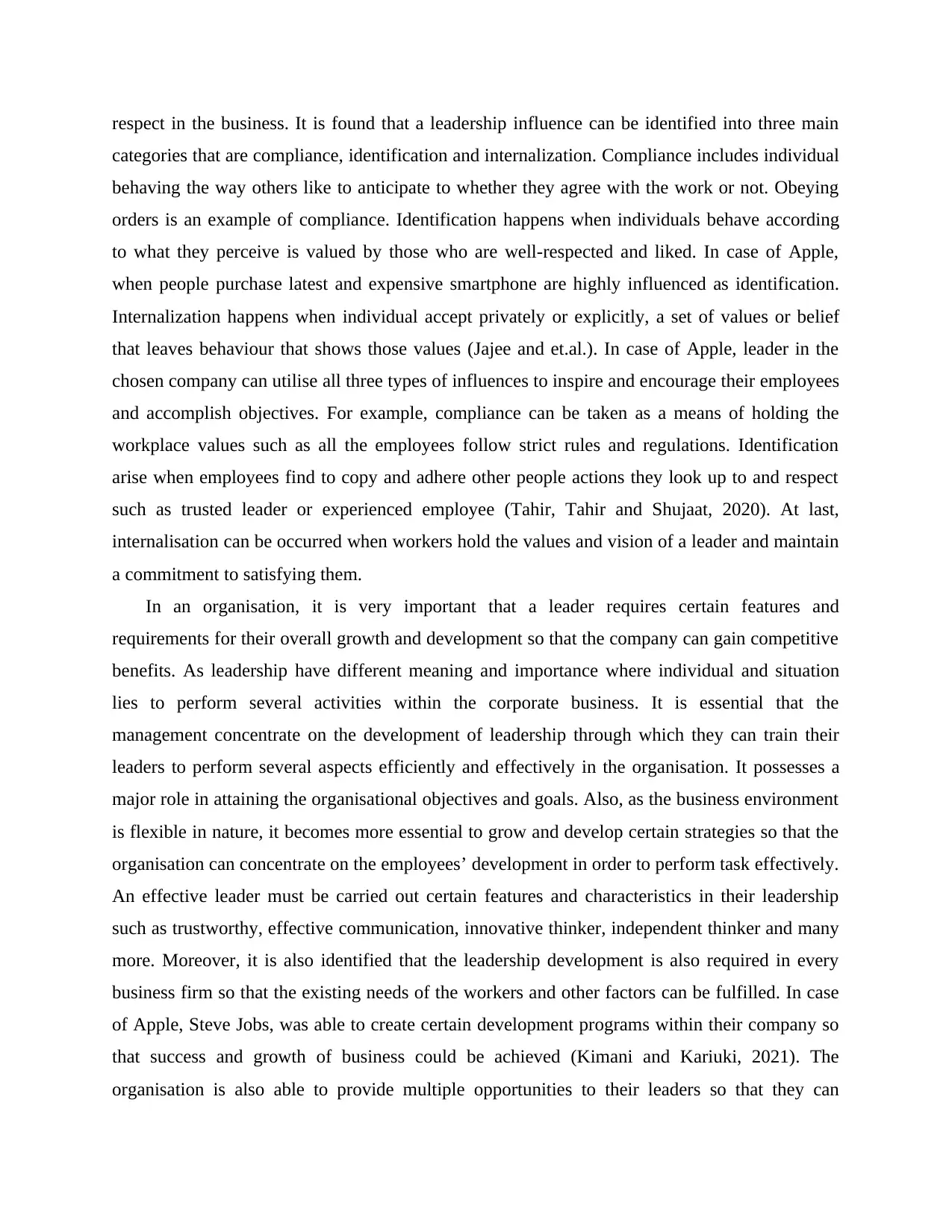
respect in the business. It is found that a leadership influence can be identified into three main
categories that are compliance, identification and internalization. Compliance includes individual
behaving the way others like to anticipate to whether they agree with the work or not. Obeying
orders is an example of compliance. Identification happens when individuals behave according
to what they perceive is valued by those who are well-respected and liked. In case of Apple,
when people purchase latest and expensive smartphone are highly influenced as identification.
Internalization happens when individual accept privately or explicitly, a set of values or belief
that leaves behaviour that shows those values (Jajee and et.al.). In case of Apple, leader in the
chosen company can utilise all three types of influences to inspire and encourage their employees
and accomplish objectives. For example, compliance can be taken as a means of holding the
workplace values such as all the employees follow strict rules and regulations. Identification
arise when employees find to copy and adhere other people actions they look up to and respect
such as trusted leader or experienced employee (Tahir, Tahir and Shujaat, 2020). At last,
internalisation can be occurred when workers hold the values and vision of a leader and maintain
a commitment to satisfying them.
In an organisation, it is very important that a leader requires certain features and
requirements for their overall growth and development so that the company can gain competitive
benefits. As leadership have different meaning and importance where individual and situation
lies to perform several activities within the corporate business. It is essential that the
management concentrate on the development of leadership through which they can train their
leaders to perform several aspects efficiently and effectively in the organisation. It possesses a
major role in attaining the organisational objectives and goals. Also, as the business environment
is flexible in nature, it becomes more essential to grow and develop certain strategies so that the
organisation can concentrate on the employees’ development in order to perform task effectively.
An effective leader must be carried out certain features and characteristics in their leadership
such as trustworthy, effective communication, innovative thinker, independent thinker and many
more. Moreover, it is also identified that the leadership development is also required in every
business firm so that the existing needs of the workers and other factors can be fulfilled. In case
of Apple, Steve Jobs, was able to create certain development programs within their company so
that success and growth of business could be achieved (Kimani and Kariuki, 2021). The
organisation is also able to provide multiple opportunities to their leaders so that they can
categories that are compliance, identification and internalization. Compliance includes individual
behaving the way others like to anticipate to whether they agree with the work or not. Obeying
orders is an example of compliance. Identification happens when individuals behave according
to what they perceive is valued by those who are well-respected and liked. In case of Apple,
when people purchase latest and expensive smartphone are highly influenced as identification.
Internalization happens when individual accept privately or explicitly, a set of values or belief
that leaves behaviour that shows those values (Jajee and et.al.). In case of Apple, leader in the
chosen company can utilise all three types of influences to inspire and encourage their employees
and accomplish objectives. For example, compliance can be taken as a means of holding the
workplace values such as all the employees follow strict rules and regulations. Identification
arise when employees find to copy and adhere other people actions they look up to and respect
such as trusted leader or experienced employee (Tahir, Tahir and Shujaat, 2020). At last,
internalisation can be occurred when workers hold the values and vision of a leader and maintain
a commitment to satisfying them.
In an organisation, it is very important that a leader requires certain features and
requirements for their overall growth and development so that the company can gain competitive
benefits. As leadership have different meaning and importance where individual and situation
lies to perform several activities within the corporate business. It is essential that the
management concentrate on the development of leadership through which they can train their
leaders to perform several aspects efficiently and effectively in the organisation. It possesses a
major role in attaining the organisational objectives and goals. Also, as the business environment
is flexible in nature, it becomes more essential to grow and develop certain strategies so that the
organisation can concentrate on the employees’ development in order to perform task effectively.
An effective leader must be carried out certain features and characteristics in their leadership
such as trustworthy, effective communication, innovative thinker, independent thinker and many
more. Moreover, it is also identified that the leadership development is also required in every
business firm so that the existing needs of the workers and other factors can be fulfilled. In case
of Apple, Steve Jobs, was able to create certain development programs within their company so
that success and growth of business could be achieved (Kimani and Kariuki, 2021). The
organisation is also able to provide multiple opportunities to their leaders so that they can
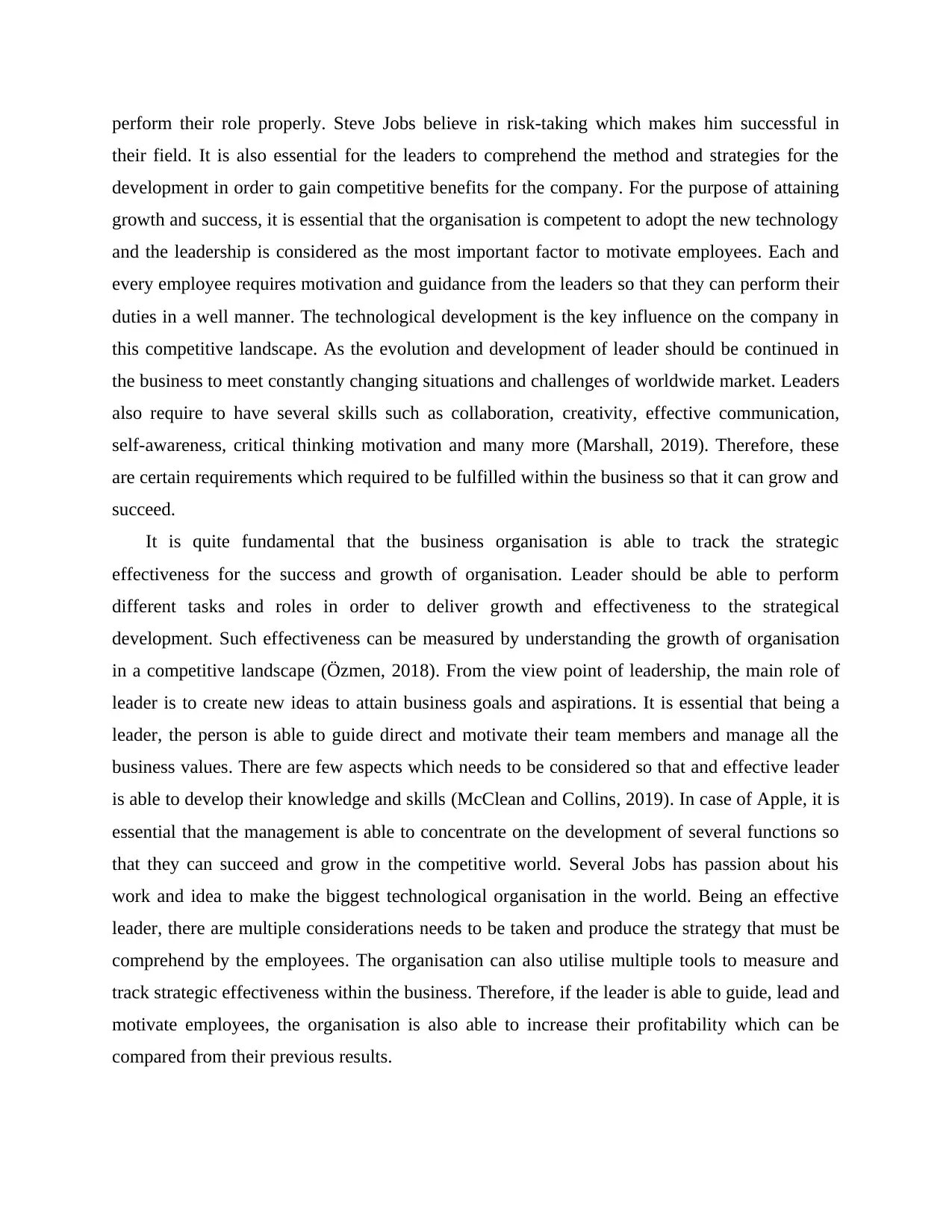
perform their role properly. Steve Jobs believe in risk-taking which makes him successful in
their field. It is also essential for the leaders to comprehend the method and strategies for the
development in order to gain competitive benefits for the company. For the purpose of attaining
growth and success, it is essential that the organisation is competent to adopt the new technology
and the leadership is considered as the most important factor to motivate employees. Each and
every employee requires motivation and guidance from the leaders so that they can perform their
duties in a well manner. The technological development is the key influence on the company in
this competitive landscape. As the evolution and development of leader should be continued in
the business to meet constantly changing situations and challenges of worldwide market. Leaders
also require to have several skills such as collaboration, creativity, effective communication,
self-awareness, critical thinking motivation and many more (Marshall, 2019). Therefore, these
are certain requirements which required to be fulfilled within the business so that it can grow and
succeed.
It is quite fundamental that the business organisation is able to track the strategic
effectiveness for the success and growth of organisation. Leader should be able to perform
different tasks and roles in order to deliver growth and effectiveness to the strategical
development. Such effectiveness can be measured by understanding the growth of organisation
in a competitive landscape (Özmen, 2018). From the view point of leadership, the main role of
leader is to create new ideas to attain business goals and aspirations. It is essential that being a
leader, the person is able to guide direct and motivate their team members and manage all the
business values. There are few aspects which needs to be considered so that and effective leader
is able to develop their knowledge and skills (McClean and Collins, 2019). In case of Apple, it is
essential that the management is able to concentrate on the development of several functions so
that they can succeed and grow in the competitive world. Several Jobs has passion about his
work and idea to make the biggest technological organisation in the world. Being an effective
leader, there are multiple considerations needs to be taken and produce the strategy that must be
comprehend by the employees. The organisation can also utilise multiple tools to measure and
track strategic effectiveness within the business. Therefore, if the leader is able to guide, lead and
motivate employees, the organisation is also able to increase their profitability which can be
compared from their previous results.
their field. It is also essential for the leaders to comprehend the method and strategies for the
development in order to gain competitive benefits for the company. For the purpose of attaining
growth and success, it is essential that the organisation is competent to adopt the new technology
and the leadership is considered as the most important factor to motivate employees. Each and
every employee requires motivation and guidance from the leaders so that they can perform their
duties in a well manner. The technological development is the key influence on the company in
this competitive landscape. As the evolution and development of leader should be continued in
the business to meet constantly changing situations and challenges of worldwide market. Leaders
also require to have several skills such as collaboration, creativity, effective communication,
self-awareness, critical thinking motivation and many more (Marshall, 2019). Therefore, these
are certain requirements which required to be fulfilled within the business so that it can grow and
succeed.
It is quite fundamental that the business organisation is able to track the strategic
effectiveness for the success and growth of organisation. Leader should be able to perform
different tasks and roles in order to deliver growth and effectiveness to the strategical
development. Such effectiveness can be measured by understanding the growth of organisation
in a competitive landscape (Özmen, 2018). From the view point of leadership, the main role of
leader is to create new ideas to attain business goals and aspirations. It is essential that being a
leader, the person is able to guide direct and motivate their team members and manage all the
business values. There are few aspects which needs to be considered so that and effective leader
is able to develop their knowledge and skills (McClean and Collins, 2019). In case of Apple, it is
essential that the management is able to concentrate on the development of several functions so
that they can succeed and grow in the competitive world. Several Jobs has passion about his
work and idea to make the biggest technological organisation in the world. Being an effective
leader, there are multiple considerations needs to be taken and produce the strategy that must be
comprehend by the employees. The organisation can also utilise multiple tools to measure and
track strategic effectiveness within the business. Therefore, if the leader is able to guide, lead and
motivate employees, the organisation is also able to increase their profitability which can be
compared from their previous results.
⊘ This is a preview!⊘
Do you want full access?
Subscribe today to unlock all pages.

Trusted by 1+ million students worldwide
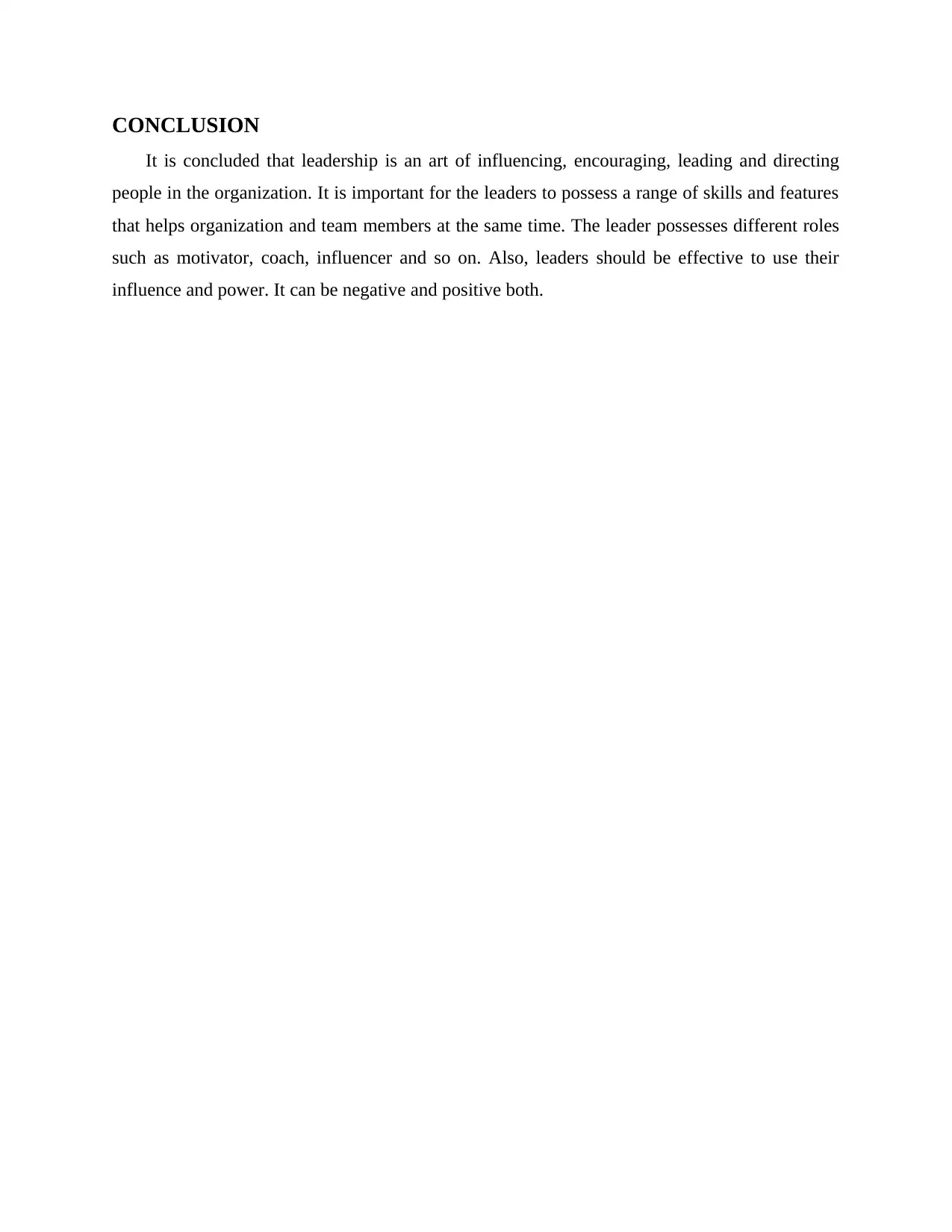
CONCLUSION
It is concluded that leadership is an art of influencing, encouraging, leading and directing
people in the organization. It is important for the leaders to possess a range of skills and features
that helps organization and team members at the same time. The leader possesses different roles
such as motivator, coach, influencer and so on. Also, leaders should be effective to use their
influence and power. It can be negative and positive both.
It is concluded that leadership is an art of influencing, encouraging, leading and directing
people in the organization. It is important for the leaders to possess a range of skills and features
that helps organization and team members at the same time. The leader possesses different roles
such as motivator, coach, influencer and so on. Also, leaders should be effective to use their
influence and power. It can be negative and positive both.
Paraphrase This Document
Need a fresh take? Get an instant paraphrase of this document with our AI Paraphraser
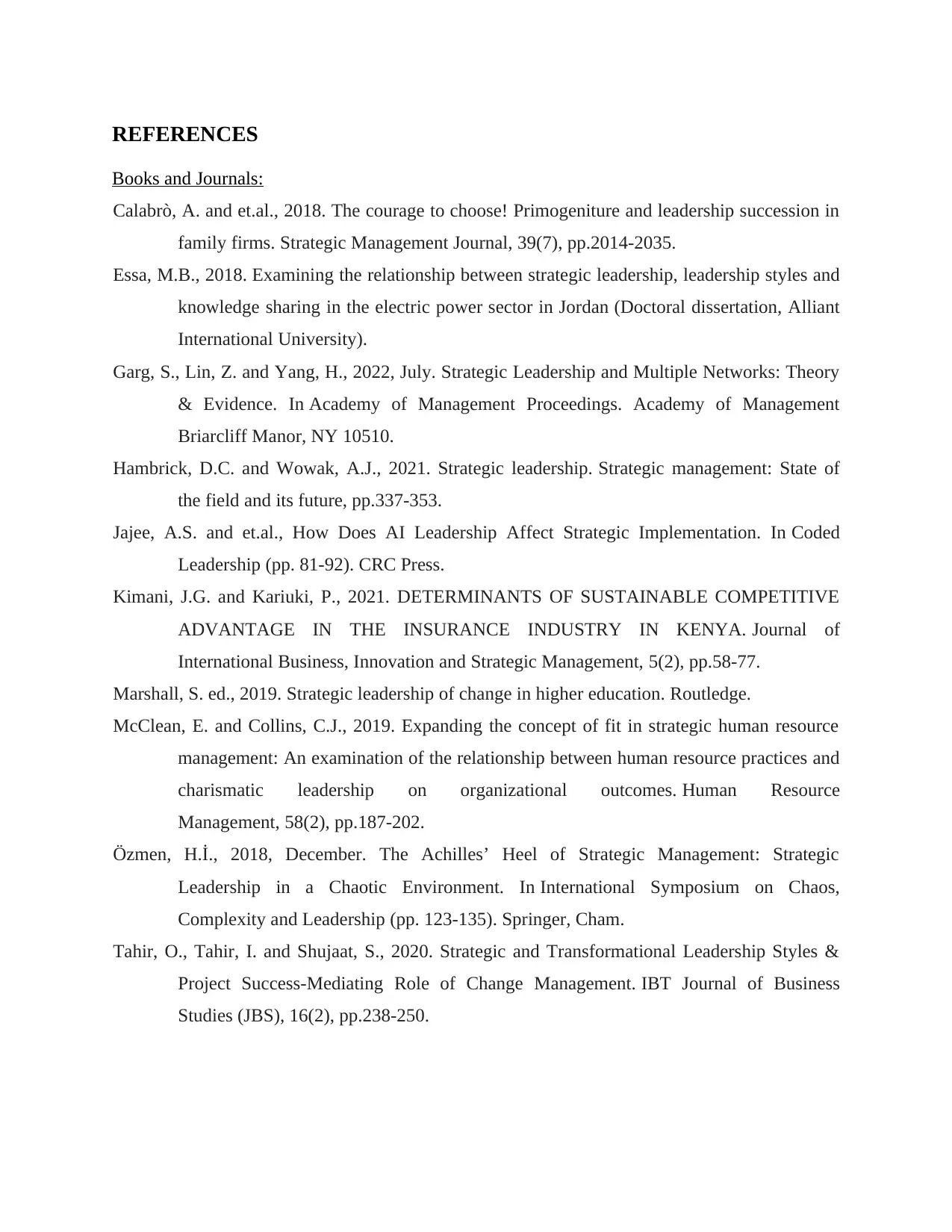
REFERENCES
Books and Journals:
Calabrò, A. and et.al., 2018. The courage to choose! Primogeniture and leadership succession in
family firms. Strategic Management Journal, 39(7), pp.2014-2035.
Essa, M.B., 2018. Examining the relationship between strategic leadership, leadership styles and
knowledge sharing in the electric power sector in Jordan (Doctoral dissertation, Alliant
International University).
Garg, S., Lin, Z. and Yang, H., 2022, July. Strategic Leadership and Multiple Networks: Theory
& Evidence. In Academy of Management Proceedings. Academy of Management
Briarcliff Manor, NY 10510.
Hambrick, D.C. and Wowak, A.J., 2021. Strategic leadership. Strategic management: State of
the field and its future, pp.337-353.
Jajee, A.S. and et.al., How Does AI Leadership Affect Strategic Implementation. In Coded
Leadership (pp. 81-92). CRC Press.
Kimani, J.G. and Kariuki, P., 2021. DETERMINANTS OF SUSTAINABLE COMPETITIVE
ADVANTAGE IN THE INSURANCE INDUSTRY IN KENYA. Journal of
International Business, Innovation and Strategic Management, 5(2), pp.58-77.
Marshall, S. ed., 2019. Strategic leadership of change in higher education. Routledge.
McClean, E. and Collins, C.J., 2019. Expanding the concept of fit in strategic human resource
management: An examination of the relationship between human resource practices and
charismatic leadership on organizational outcomes. Human Resource
Management, 58(2), pp.187-202.
Özmen, H.İ., 2018, December. The Achilles’ Heel of Strategic Management: Strategic
Leadership in a Chaotic Environment. In International Symposium on Chaos,
Complexity and Leadership (pp. 123-135). Springer, Cham.
Tahir, O., Tahir, I. and Shujaat, S., 2020. Strategic and Transformational Leadership Styles &
Project Success-Mediating Role of Change Management. IBT Journal of Business
Studies (JBS), 16(2), pp.238-250.
Books and Journals:
Calabrò, A. and et.al., 2018. The courage to choose! Primogeniture and leadership succession in
family firms. Strategic Management Journal, 39(7), pp.2014-2035.
Essa, M.B., 2018. Examining the relationship between strategic leadership, leadership styles and
knowledge sharing in the electric power sector in Jordan (Doctoral dissertation, Alliant
International University).
Garg, S., Lin, Z. and Yang, H., 2022, July. Strategic Leadership and Multiple Networks: Theory
& Evidence. In Academy of Management Proceedings. Academy of Management
Briarcliff Manor, NY 10510.
Hambrick, D.C. and Wowak, A.J., 2021. Strategic leadership. Strategic management: State of
the field and its future, pp.337-353.
Jajee, A.S. and et.al., How Does AI Leadership Affect Strategic Implementation. In Coded
Leadership (pp. 81-92). CRC Press.
Kimani, J.G. and Kariuki, P., 2021. DETERMINANTS OF SUSTAINABLE COMPETITIVE
ADVANTAGE IN THE INSURANCE INDUSTRY IN KENYA. Journal of
International Business, Innovation and Strategic Management, 5(2), pp.58-77.
Marshall, S. ed., 2019. Strategic leadership of change in higher education. Routledge.
McClean, E. and Collins, C.J., 2019. Expanding the concept of fit in strategic human resource
management: An examination of the relationship between human resource practices and
charismatic leadership on organizational outcomes. Human Resource
Management, 58(2), pp.187-202.
Özmen, H.İ., 2018, December. The Achilles’ Heel of Strategic Management: Strategic
Leadership in a Chaotic Environment. In International Symposium on Chaos,
Complexity and Leadership (pp. 123-135). Springer, Cham.
Tahir, O., Tahir, I. and Shujaat, S., 2020. Strategic and Transformational Leadership Styles &
Project Success-Mediating Role of Change Management. IBT Journal of Business
Studies (JBS), 16(2), pp.238-250.
1 out of 8
Related Documents
Your All-in-One AI-Powered Toolkit for Academic Success.
+13062052269
info@desklib.com
Available 24*7 on WhatsApp / Email
![[object Object]](/_next/static/media/star-bottom.7253800d.svg)
Unlock your academic potential
Copyright © 2020–2025 A2Z Services. All Rights Reserved. Developed and managed by ZUCOL.




